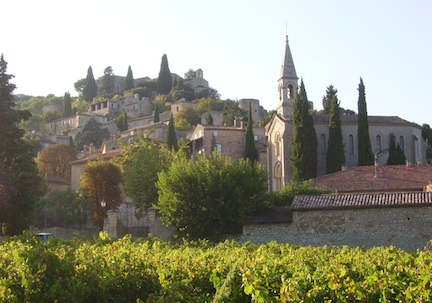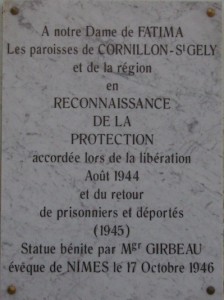 We’ve found the prettiest village in France. Officially, it’s only one of the prettiest this year and only for the past six years.
We’ve found the prettiest village in France. Officially, it’s only one of the prettiest this year and only for the past six years.
At the top of the hill is a real medieval chateau in which lives a real (presumably French, as they don’t like to sell significant symbols of their patrimony) family. I don’t know if they are of the same line of seigneurs de la Roque-sur-Cèze as the one who lived there in the 12th century, and set off to rescue the princess of Verfeuille (another picturesque walled town, about 15 minutes away driving) when he heard she was abducted.
He was successful, by the way, but on the return to the-Rock-on-the-Cèze-River (and why he was bringing her there, when he should have been bringing her home to the bosom of her loving family is a question only modern cynics would ask), she fainted at the chapel of Saint Sauveur. He awoke her with a kiss (the panacea for all damsels in distress at the time…. Or maybe it was the “kiss” that was the problem) and asked her to marry him. I’m sure that made her feel much better.
Because of this legend, the chapel has a reputation of bringing happy-ever-after to all lovers. The chapel hill is also where the monument to lost and deported victims of WWII stands, so some of the ecclesiastic ruins display graffiti from those who fought in the war.
 Hope and grief, on one hilltop.
Hope and grief, on one hilltop.
La Roque-sur-Cèze is one river valley and one hill away from the chapel. Judging from the names on the post boxes, the former-seigneur’s village owns its recent renaissance to an infestation of Brits. Brits with loads of moulah. Even the streets are cobbled. Ce n’est pas typique.
For instance, in another picturesque bastide (medieval walled fortress town) on a hilltop across the Cèze valley in the other direction (west) from St-Gély, Cornillon has asphalted over the cobblestones of its twisty, windy, narrow streets. I can only presume this is why the last time it was officially named “one of the prettiest villages in France” was in 2006.
It’s so darn picturesque here. Medieval buildings, “perched” villages, cafes with awnings and abrupt waiters perfunctorily serving you café ou vin (but who also remember exactly what you ordered the first time in when you wander in again two days later), and field upon field of vines.



You must be logged in to leave a reply.